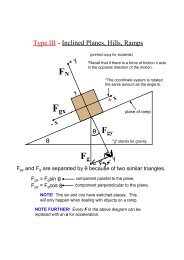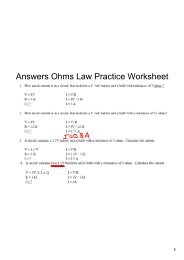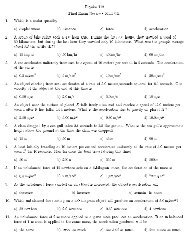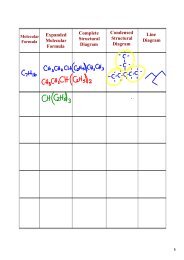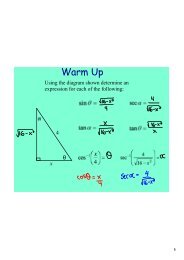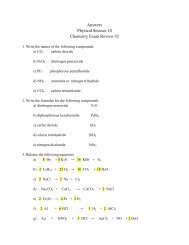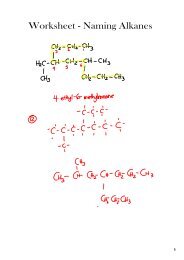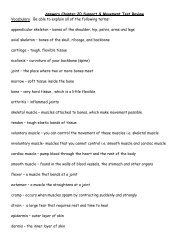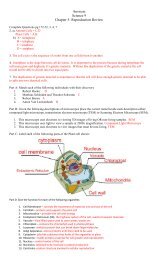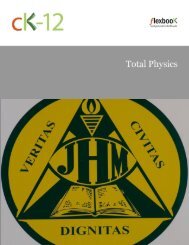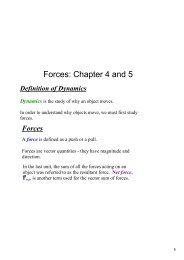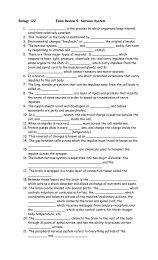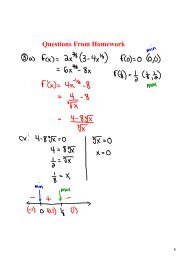Physics Study Guides.pdf - James M. Hill Memorial High School
Physics Study Guides.pdf - James M. Hill Memorial High School
Physics Study Guides.pdf - James M. Hill Memorial High School
You also want an ePaper? Increase the reach of your titles
YUMPU automatically turns print PDFs into web optimized ePapers that Google loves.
Electrical SystemsBig Picture<strong>Study</strong> <strong>Guides</strong>Electrical systems involve the flow of electric charge through circuits of conducting material, usually a wire or metalcable. If there is a difference in voltage across a conductor, electrons will flow from the high voltage to low voltagecreating a current. Current can be used to transfer energy between two points along a wire; this is the basis of allelectronic devices. Unlike electrostatics which is mainly concerned with the activity of individual charges, electricalsystems involve the movement of many electrons and the combined effects of the moving charges.<strong>Physics</strong>Disclaimer:Key TermsVoltage Source: A power source that provides a fixedvoltage, usually a battery. While the voltage sourcehas a certain amount of voltage available (alsoknown as emf, or electromotive force), it tends tohave some resistance, meaning the actual voltage(called the terminal voltage) it provides is less thanthe emf. SI unit: VVoltage causes currents - think of voltage ashow much force is pushing an electric current!Voltage: Potential energy, measured as a differencebetween potential at two points in space. SI units: VVoltmeter: Measures the potential difference (voltage)between two points in a circuit.Current: The flow of electric charges through a wire. SIunits: AAmmeter: Measures current.Resistance: The amount a device opposes the flow of acurrent. SI units: ΩCapacitance: A device’s capacity to store charge. SIunits: FOhm’s Law: The current between two points througha conductor is directly proportional to the voltagebetween those two points and inversely proportionalto the resistance between those two points.Power: The concept of power in electrical systems isexactly the same as in mechanics: the rate of energytransfer. However, power in electrical systems iscalculated with different formulas. SI units: JDC Circuits: Also known as direct current circuits,electrons in DC circuits are constantly moving alonga wire towards the positive charge.RC Circuits: Circuit comprised of resistors and capacitorsconnected to a voltage source.Can you guess what the R and C in RC circuitstand for now?CircuitsCircuits include a voltage source (usually a battery) and a conducting wire connecting opposite ends of the voltagesource, providing a closed loop for charge to flow (DC circuits). Some other elements that may be included in a circuitare resistors and capacitors.In circuit diagrams, we use these symbols:When working with circuit diagrams, we are usually calculating one of the following:• voltage• current• resistance• capacitance (if capacitors are included)Ohm’s law relates current (I), voltage (V), and resistance (R): V = IR.Two other important rules are Kirchoff’s laws:• Kirchoff’s Law for Voltage (also known as the Loop Rule): The sum of all the potential differences in a given loopis equal to 0.• Kirchoff’s Law for Current (also known as the Junction Rule): At any junction, the sum of the current flowing inequals the sum of the current flowing out.ResistorsResistors are devices that resist the flow of current and are used to control the current flowing through a circuit. Thepower that a battery provides can be calculated by P = IV. This power flows through the circuit until it hits a resistor,which dissipates some energy. This energy goes into heating the resistor.Resistance is low in a conductor and high in an insulator.This guide was created by Christopher Addiego and Catherine Wu. To learnmore about the student authors, visit http://www.ck12.org/about/about-us/team/interns.Page 1 of 3v1.1.10.2012this study guide was not created to replaceyour textbook and is for classroom or individual use only.




